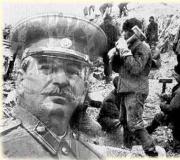Pictures of silhouettes on a dark background. How is a proportional silhouette of a person created on paper? Mannequins-silhouettes of people for drawing to help
Who doesn’t remember the famous work of Leonardo da Vinci, where the artistic diagram clearly illustrates the proportionality of the human body. Harmoniously designed, it looks incredibly beautiful. But we ourselves need to figure out how to draw a person. It is worth learning to convey this harmony of proportions of the human body. How? Now I will try to show what discoveries I have made for myself in drawing the human figure.
I will be helped by some kind of guide on how to draw the human body, a set for creativity from the items necessary for every artist, both a professional and a beginner, for example, a preschooler: paper, pencils, a ruler and an eraser. My son, who is 7 years old, will also come to my rescue.. My baby and I decided that our model of a person was a man in jeans and a T-shirt. We found his photograph on one of the websites.
But I would like to note right away that this step-by-step instruction assumes that those who follow these drawing lessons will be able to easily repeat any step. And it won’t be difficult even for a child to do this..
We distribute the entire execution of a person’s drawing into several stages:
- Support work;
- Picture detail;
- We “revive” the drawing of a human figure.
Support work
First of all, we make a schematic sketch, taking into account the proportions of the person.
How to draw sketches of people correctly? To do this you need to start small. We make an image of an oval. This will be the head. We measure its size. I got it to be 2 cm long. The proportions of a person are such that you need to measure only 7 of these lengths to depict a person of average height.

Here's a sketch of the silhouette. It’s difficult to see a picture of a person in this. But this is how we will understand how to draw a full-length person.

Now we are waiting for exclusively step-by-step work.
Neck.
A person's neck can be different. But I went by the average. The neck is usually no wider than the head, and at the same time not too thin, about half the width of the head.Do not forget that this is a pencil drawing for beginners and there may be some inaccuracies in it. With practice, you can achieve good success and even understand how to teach a child to draw a person, no matter how old he is.

Shoulders.
To draw the shoulder line, it is important to take into account the fact that on average a man has them the same length as his head. And one moment. Draw the shoulders with a slight downward slope (see picture above).Waist.
How to draw a human figure? The next point is how to “find” and draw our person’s waist. Marking will help with this. If my head is 2 cm, then I will define my waist below the fifth cm, approximately 5.2-5.3. I put a point and from it I draw a horizontal line, which will be greater than the width of the head, but less than the span of the shoulders. I connect this line with the shoulder line.
Torso.
The fourth mark (from top to bottom) will be the point of the lower torso. It is usually wider than the waist, but should not be wider than the shoulders. Draw a horizontal line. We connect its edges with the waist.
Legs.
The drawing of a person should be complemented by the “making” of the legs. How easy is it to do this? Let's divide this stage into several steps:
Hands.
We are approaching the final stage and complementing the drawing of a person with another important detail - the hands. And again we divide this step of drawing a person with a pencil step by step: In general, we figured out how to draw a figure. But that is not all. Now the model needs some details to be worked out.
In general, we figured out how to draw a figure. But that is not all. Now the model needs some details to be worked out. Picture detail
Our pencil-drawn person needs a face to “appear.” And that’s why we depict each element in the picture. And these are ears, hairstyle, eyes, nose and eyebrows.
We were able to draw a human figure. But this was just a diagram. Now we work on each detail of his clothing separately. We make folds on the clothes, and even mark some noticeable seams.

Erase all auxiliary lines. And now we see that this is more reminiscent of a human appearance than the picture of a robot “on hinges” was until now.

Let's bring our model to life
We figured out how to draw the body. And now we will dress this body. In the photo that we chose as a model, there is a man in jeans and a T-shirt. We show all this in our image.
Don’t forget about the chiaroscuro effect, as this makes the work more voluminous.

If until now it was difficult to explain some points to children, then even a child who is one or two years old can cope with the coloring stage.

The child and I tried our best and we ended up with a pretty handsome man. Perhaps in the future we will be able to learn to portray a girl and a child. The main thing is the beginning. Good luck in your future practice!
See below for a few more options.
Silhouette drawing "Deer". Master class with step-by-step photos.
This master class can be used in art lessons with elementary school students.
Goal of the work: teach children silhouette drawing.
Tasks:get acquainted with the history of silhouette drawing;
learn to perform work using this technique.
One type of graphics is silhouette drawing. In the 18th century, at the court of the French king Louis XV, the minister of finance was the nobleman Etienne de Silhouette (1709 - 1767). One day, some artist drew a caricature of him. It was made unusually, like a shadow. This method of depiction began to be called a silhouette, named after the minister.In a broad sense, “silhouette” is the outline of an object, similar to its shadow.
In a narrow sense, “silhouette” is a type of drawing, i.e. a flat, monochromatic image of figures and objects.
A silhouette drawn or cut out on paper and then glued to the background forms a solid, contoured, dark or light spot against a contrasting background.
It is impossible to show facial features or any details in a silhouette drawing, so the external outlines of each figure must be expressive.
Favorite genres of silhouette drawing were profile portraits, everyday scenes, illustrations, and still lifes.
Progress:
For our drawing we need the following materials: drawing of a deer silhouette, gouache, brushes.

Let's start coloring the sunset sky. For this we need purple, orange and red gouache. In plates or on a palette, dilute gouache with water. Using a large brush, apply about 4 cm of purple paint on top of our drawing.

While our gouache is still wet, we take orange gouache and continue painting the sky.

We pass along the orange one with red gouache, and gradually move on to purple. We try to make our sky uniform, so that there are no sharp transitions in the color of the gouache. We must paint over the entire sheet along with the deer. The most important thing: you need to make sure that the paper does not get too wet!

Let our work dry thoroughly. Now we need to paint our deer with black gouache. For this we need a medium-sized brush. We also draw the hill on which our deer stands. They stand out well against the sky A.


Art posters depicting silhouettes of people present us with paintings by a variety of artists. Their unique view of the world, the peculiarities of their creative style and personal qualities determined the choice of this method of depicting a person, when understatement becomes the semantic center of the composition. This type of portrait leaves room for speculation.
Considering many elements, the story turns out to be not a complete story with a plot, a plot and an epilogue, but a hint of a narrative, a poetic touch superimposed on the context of our perception. The symbolism and vagueness of the picture make it possible for the viewer to actively participate in the fate of the hero - everyone is free to imagine their own plot with their own twists and surprises. Such art posters change depending on the time of year, lighting and, of course, the mood of the person who sees it. Every artist tried in his own way to solve the problem of representing his hero in such a way that much remained secret and incomprehensible. From the refined, heavenly sublime silhouettes of Raphael to the dancing, artistically broken figures of Toulouse-Lautrec, from the bright vital excess of Botticelli’s images to the washed-out characters of George Hunter, hidden by the veil of foggy years, one can trace the paths along which painting developed. But in each picture there are several meanings and contents that fit so well into this multi-valued form. Art posters representing silhouettes of people will never get boring - each time they allow you to see the captured images in a completely new way and understand the story encrypted in the image.
Like any other image, the silhouette of a person on paper begins to appear from the simplest lines. In many cases, at the first stages, the artist’s future idea is not entirely clear to those around him, however, when he draws more specific outlines that indicate to us that this is a human figure, the image becomes much more understandable. Therefore, in this article we will look at how you can correctly and proportionally draw a full-length figure, and also talk about what a novice brush master will need for this.
Equipment for drawing
In order to draw a silhouette of a person, we first need a sheet of paper, any plain paper, preferably the one with which you are most comfortable working), an eraser, and ink or black gouache. In fine art, it is generally accepted that drawing the schematic outlines of any object, including a human figure, onto paper or canvas, on the one hand, is very simple, but on the other hand, this technique requires certain knowledge and even skills. Of course, when drawing a black picture, you don’t have to deal with light and shadows, you don’t need to play with colors, trying to give a natural shade to the skin, eyes, etc., however, such, at first glance, primitive pictures should have a special aura and contain meaning . Only then is it considered that the image was made correctly and correctly.
Like a person with proper proportions?
It is important that the figure of the “black man” is proportional. Therefore, we take the head as the basic unit of measurement. Draw an ellipse and measure its height. As a result, the body must accommodate seven such lengths plus the head itself. Of course, this proportion is too idealized and is more suitable for men than for women, but it is extremely useful, especially for beginners. As for hand parameters, it is important to consider the following aspect. The length from the elbow to the hand should be equal to the length from the knee to the foot. In turn, the palm should always reach the shoulder. Also, do not forget that the length of a man’s foot should be longer than that of a woman.

Mannequins-silhouettes of people for drawing to help
If it is difficult for you to grasp and convey on paper the proportions of the human body, then a small wooden mannequin will be your ideal ally in this matter. These can be bought at an art salon, and then used forever. The beauty of such a “toy” is that it accurately conveys not only the proportions, but also the movements that a person can make in reality. You can place the mannequin in any position you need and, simply copying the proportions, transfer what you see to paper. If you can’t transfer all the dimensions at a distance, at the initial stages you can simply trace the little man by placing him on a piece of paper. This way you will grasp the essence of drawing, and in the future things will go easier.

Filling our picture
Finally, the whole person needs to be painted over with black paint or ink. This is necessary so that you can hide construction lines, various dotted lines and other working aspects. When the drawing dries, it can be supplemented with any other elements of the landscape that will create the integrity of the composition.




